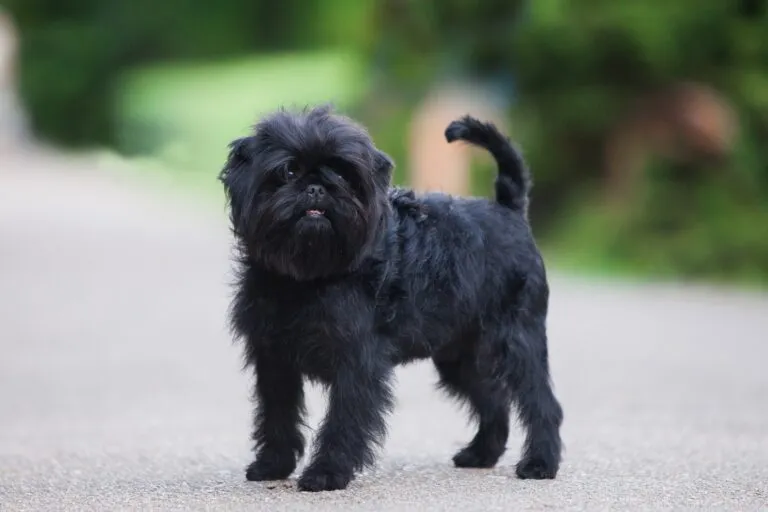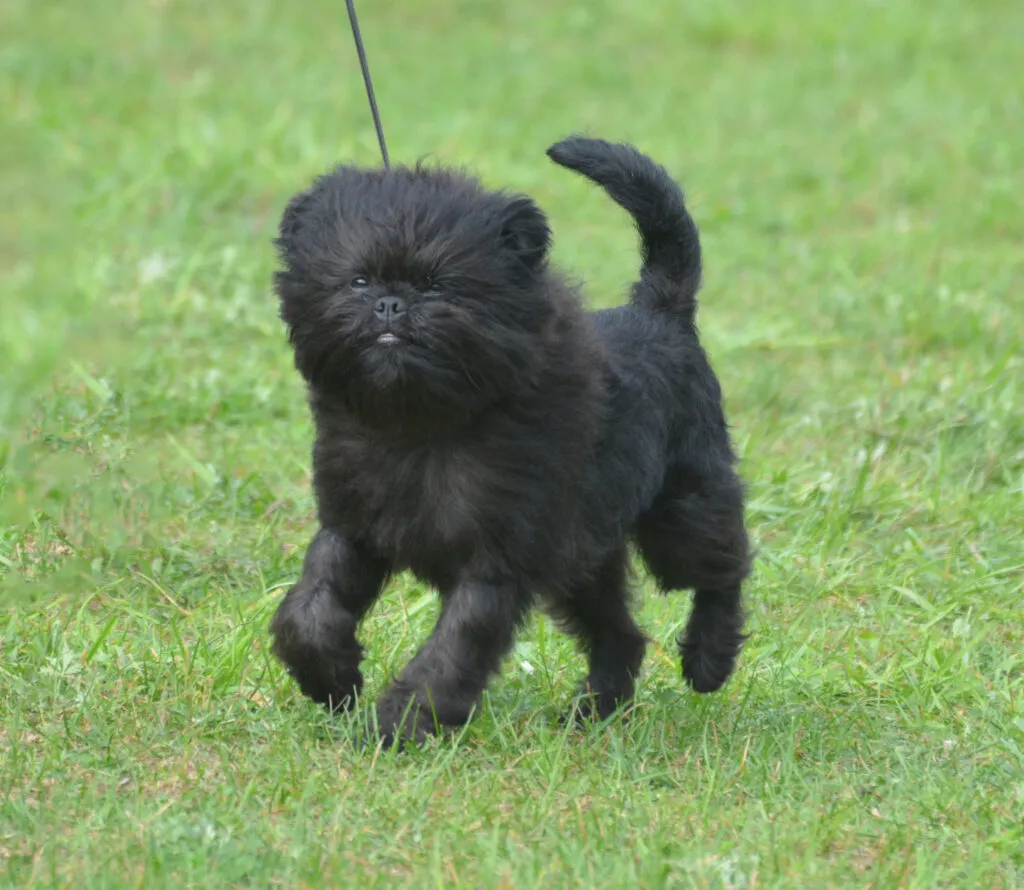Medium Size Poodle
The Affenpinscher is one of Germany’s oldest and most original dog breeds. Standing at about 30 cm, it may be quite small, but don’t underestimate this little chap. Its fiery temperament, passionate courage and endearing cheekiness make it a large personality.

© Ilona Didkovska / stock.adobe.com
The loyal and courageous Affenpinscher is one of the rarer dog breeds
The Affenpinscher is well-known for its beard and topknot hair that should stand out hard and stringy. These two features give it the rather unflattering name “Affenpinscher”.
Its almost monkey-like facial expression is intensified by its rather flat nose, round eyes and the undershot jaw, which differentiates it from other Pinschers. Besides its undershot jaw, the shortened snout and rough fur make this dog quite unique.
It’s sometimes mistaken for a Griffon, but unlike that breed, its muzzle is less broad and long. With the mouth closed, its teeth should not be visible.
Historically, Affenpinschers were found in many colours and shades ranging from yellow to red, grey and blue. Today, breed enthusiasts adhere to the standard, which stipulates that the Affenpinscher is only bred in black with black undercoat.
The hair is of a harsh texture and forms a remarkable adornment on the head with bushy eyebrows, a full beard and spiky topknot hair. Its round eyes are surrounded by slightly unruly hair in a wreath-like manner.
Affenpinscher puppies usually have black fur with a similarly black undercoat. Occasionally, grey or brown shades might appear. If you like the Affenpinscher, you might also want to look at these breeds:
 © dejavudesigns / stock.adobe.com
© dejavudesigns / stock.adobe.com
Boredom is the worst for this spirited little dog. The lively Affenpinscher enjoys any form of excitement and is thrilled by long walks or playtime, showing great endurance and enthusiasm.
It gets along well with other dogs and loves to romp in the dog park. It generally gets on well with children who share its playfulness, although it can clearly show if something doesn’t please it.
The Affenpinscher has a mind of its own. It can sometimes be cheeky or stubborn if things don’t go its way. However, its friendly nature makes it easy to forgive. Moreover, it’s not resentful and can be easily distracted with a short game.
Thanks to its high intelligence, it quickly understands what is expected of it. Despite its wilfulness, it is a very adaptable and uncomplicated dog that fits in well everywhere.
It is always loyal to its human and proves to be a very affectionate and cuddly companion. Its role as the family “watchdog” is taken very seriously and carried out with great courage. This can sometimes make strangers see it as a small, choleric “devil”. It’s not without reason that in French, it is called “Diabletin Moustachu”, which translates to “little devil with the bearded face“.
To be happy, Affenpinschers don’t need much more than the close company of their humans. These affectionate and people-oriented little dogs have very few demands regarding their surroundings. They are equally comfortable in a small city flat or a large house with a garden and adapt well to almost any environment.
Due to their people-oriented nature and adaptable character, Affenpinschers are generally considered easy to train. They learn quickly and are always ready to follow their owner. Nonetheless, the breed is also known for a certain stubbornness, which can sometimes lead to issues in training. Lack of consistency can turn this lovable little guy into a fiery tyrant.
It’s essential that Affenpinschers get enough exercise. They love long, varied walks and enjoy playing and romping in nature, whether with family or other dogs. Despite their small size, their endurance and need for activity should never be underestimated.
Fortunately, Affenpinschers are always up for a game, so finding opportunities to keep them busy shouldn’t be too difficult. Their playfulness and quick understanding make them very grateful and uncomplicated dogs who can quickly become enthusiastic about new exercises, dog sports or other activities with their human.
Before your Affenpinscher arrives, you should already have some basic equipment ready for your new favourite. This includes bowls for food and water, a lead with harness or collar, a dog bed and dog toys.
Since coat care is essential for Affenpinschers, you should have a mild dog shampoo and brush ready. For emergencies, it’s advisable to have a flea comb and tick remover. For transporting your Affenpinscher, a simple transport box is ideal due to its small size.
Missing something? Discover the dog accessories range in our zooplus shop!
Affenpinschers generally don’t have intolerances, allergies, a propensity for obesity or medical conditions that require special food. This makes feeding these dogs relatively straightforward.
They do not need special dog food and can handle regular dry or wet food, homemade or raw foods. The question of what to put in your dog’s bowl remains a challenge given the wide variety of dog foods and dietary options available.
The best food for your dog depends on its individual needs. You should always adjust your dog’s diet to its lifestyle and circumstances as nutritional needs vary from dog to dog and can change throughout its life.
When in doubt, rely less on manufacturers’ promises and more on your breeder’s or vet’s recommendations. A diet table tailored to your dog’s age, weight, activity level and health can provide an overview of what it needs for a healthy and active life.
High-quality meat, some vegetables and essential fats are fundamental in any good dog food. Avoid grain and other filler ingredients, as well as sweeteners or chemical preservatives, in your dog’s bowl.
The Affenpinscher’s demands for coat care are higher than for its nutrition. Although the breed is often described as easy to care for, that doesn’t mean the care is quick.
That’s certainly not the case for the Affenpinscher. Its long black fur requires regular brushing and combing to stay clean and tangle-free. Moreover, it should be trimmed at least twice a year. Bathing should be reserved for when it’s absolutely necessary.
To make the care of your Affenpinscher a smooth process, introduce your dog to care rituals as early as possible. Establish set times for grooming and focus exclusively on its fur, teeth, ears and eyes during this time.
Bond the brushing and inspection with positive experiences: pet your dog, give it attention and teach it that staying still while being pampered is rewarding.
Due to the dense black fur, trimming dog nails can become uncomfortable if too much is cut accidentally. If unsure, leave the necessary and regular nail trimming to your vet.
Adopting an Affenpinscher puppy is a long-term commitment. Their average life expectancy is a remarkable 15 years. This longevity is due to the breed’s minimal alteration since its origin, maintaining its original and robust state.
Affenpinschers never became a fashion dog, which spared them from many breed-specific diseases. They generally enjoy excellent health.
With the advent of industrialisation and breeding of new dog breeds that increasingly valued appearance alongside temperament, the demand for the little ratter with the monkey-like expression declined.
Currently, only about 20 to 30 puppies are born annually in the breed’s home country, Germany. Another reason for the small number of puppies is that Affenpinschers often have only two to three puppies per litter. Nonetheless, some breeders in other countries are dedicated to this unique breed.
Besides the official FCI standard adopted by the German “Pinscher-Schnauzer-Klub 1895”, there are also standards in the British Kennel Club (KC) and the American Kennel Club (AKC) that slightly differ from the FCI standard.
Anyone interested in a purebred Affenpinscher may need to wait for a puppy. Finding a suitable breeder can be challenging due to distances and the small number of puppies available.
Once you find a breeder, it’s tempting to act quickly. However, as with all dogs, don’t rush when buying an Affenpinscher. Take a close look at the breeder and ensure you get the necessary papers with the FCI logo that certify the puppy as healthy and of good temperament.
If you care less about pedigree, consider visiting the local animal shelter.
The exact ancestry of the Affenpinscher is hard to trace since small, scruffy dogs existed in many countries. It’s likely that the Affenpinscher resulted from crossing Pinschers with Asian, pug-like dogs.
Even the little dog type depicted by Flemish painter Jan van Eyck in 1434 might be an ancestor of the Griffons, Miniature Schnauzers or Affenpinschers. It is certain that the Affenpinscher has been around in its current form for quite some time.
In Germany, regarded as the breed’s homeland, Affenpinschers are among the oldest and least altered dog breeds. Even Albrecht Dürer (1471-1528) depicted dogs resembling the modern Affenpinscher in his woodcuts.
First entries of Affenpinschers date back to 1879. The well-known reference book Brehm’s Animal Life from 1890 describes the breed in great detail, reflecting its popularity in its homeland.
Originally, people kept and bred this dog primarily as a ratter to keep rats and mice away. Soon, their loyal nature made them cherished by families. Their courage and alertness also made them reliable guard dogs.
Despite its small size and reputation as a “beginner’s dog”, training an Affenpinscher should not be taken lightly. For beginners, attending a dog school can be helpful to learn the fundamentals of keeping and training this dog.
Those who master the basic rules and train their dog lovingly and consistently will soon enjoy their Affenpinscher.
As Alfred Edmund Brehm wrote in his renowned reference book Brehm’s Animal Life in 1890: “The dog must be regarded as one of the best. It is a lively and entertaining animal, very devoted to its human, flattering and caressing to its friends (…).”
Fans of the Bearded Collie agree that those who aren't familiar with this dog breed simply have to get acquainted with it. And those who have experienced how a Bearded Collie bolts across meadows with its flowing fur, how it rolls around full of energy and joy and how it attentively and observantly takes into account its owners wishes become simply addicted to this original dog breed and its unique charm.
The Goldendoodle isn't a breed, but a pairing between Golden Retrievers and Medium or Standard Poodles. Marketed as a low-maintenance dog for allergy sufferers, this hybrid is enjoying increasing popularity amongst dog lovers, similar to the Labradoodle.